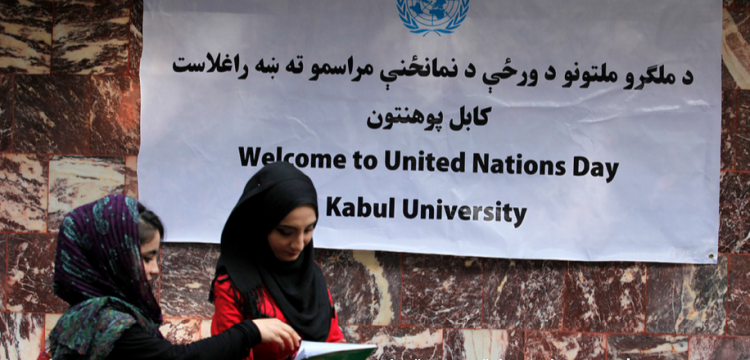Afghan students face integrational issues in universities
Enakshi Sengupta
American University of Kurdistan, Kurdistan, Northern Iraq
“We carry our bag full of books and they think we have bombs with us”. “If we wear a hijab (head scarf) they think we are different from them and will not understand their jokes.” “Why do I have to take the initiative of befriending them, why do I need to be nice to them or smile at them?”(Student A, from the Qualitative study).
Afghanistan’s nation-wide literacy rate has seen a country wide growth since the year 2008. The youth literacy rates has increased by more than 16% and at present more than 8 million students are enrolled in schools, including more than 2.5 million girls. In 2013, one million Afghan learners are enrolled in schools with the assistance received from USAID. (http://www.usaid.gov/afghanistan/education).
With the world opening its doors to Afghan students it is becoming imperative for the institutions of higher education who have invited these students to realize the impact of pluralism (Kuh 1990) and to educate its faculty and students on the significance of multi-culturalism and inter-cultural competencies. Yet, sometimes the truth is just the opposite. “Despite paying lip service to various aspects of internationalization, institutions are failing to make the most of the opportunity to engage in a radical reassessment of higher educational purposes, priorities and processes that student diversity and multi-cultural interaction provide” (De Vita and Case, 2003, p. 384).
A qualitative study conducted among Afghan students studying in both India and in Central Asia reveals that universities are moving away from the principles of cultural exchange, altruistic internationalism and reciprocity (Shinn et al., 1999). As argued by Hodson and Thomas (2001, p. 110), “this lack of cultural sensitivity in existing collaborative audit approaches…constrains diversity and is likely to drive the system down the compliance end of the quality continuum and away from quality enhancement”.
The qualitative interview conducted by the author revealed themes such as stereotyping of Afghan students, viewing Afghan students as potential terrorist and Islamic fundamentalist, ignorance and apathy towards them. “They ask us do you have schools and colleges in Kabul?” (Student A, from the qualitative study). “Faculty members ignores us, they speak in Russian and explain the concepts in Russian, if you tell them they say it’s your solution, if you complain about them they give you “F” in your exams, then why did they bring us here?” (Student D, from the qualitative study).
It becomes incumbent for every university that various activities under the umbrella of student affairs should join together to assume their responsibility in supporting, facilitating, and enhancing this multicultural mission faced by institutions of higher learning (Grieger, 1996). The foundation years are critical and the foundation courses are not doing enough.
“The foundation courses do not give us any cultural induction, they do not help us in understanding the community, they have no concrete programme in place to induct or integrate us” (Student C, from the qualitative study). The department welcoming them needs to be sensitive towards the unique needs experienced by these Afghan students. The student service departments must be knowledgeable concerning their adjustment issues that at times leads to emotional or psychological stress. Developing adequate support services is extremely important for this group of new students (Tidwell et. al. 2002).
These Afghan students unlike immigrants, often arrive alone and have predetermined academic pressures to endure that are set by their native countries as well as themselves (Sue, 1997). “It is important to break the stereotypes that have made our life miserable in many parts of the world, just because some people in Afghanistan have deviated from the right path does not mean everyone has to pay for their dastardly actions.” (Fazel Haq, http://scroll.in/article/690848/afghan-students-in-india-find-doors-both-closed-and-open).
As Volet and Ang (1998) point out, interacting with each other and creating a learning environment where students are exposed to multiple perspectives and foster cultural understandings is often missing. Hence policies are not enough unless the universities take the initiative of creating a challenging hybrid culture with multifarious cultural perspectives and experiences of those who make up the faculty who can be seen as people inspiring the creation of new learning practices (De Vita and Case, 2003).
It is becoming increasingly important to understand these students from Afghanistan and to assess and address their needs. These Afghan students bring their cultural orientations with them: values, beliefs, patterns of behaviour, ways of learning, and thinking. They help enrich the intellectual life of a campus, and universities inviting these students should undertake an affirmative step towards integrating them through well-crafted programmes and make them feel a part of their universe.
Copyright © [2016] Enakshi Sengupta
Disclaimer
Opinions expressed in this article are those of the author, and as such do not necessarily represent the position(s) of other professionals or any institution.
References
Educational Exchanges and Scholarship Opportunities for Citizens of Afghanistan. http://kabul.usembassy.gov/educational_exchange.html. Downloaded on 17th July 2015. Education. http://www.usaid.gov/afghanistan/education. Downloaded on 17th July 2015.
Grieger, I. (1996). A multicultural organizational development checklist for student affairs. Journal of College Student Development, 37, 561-573.
Kuh, G. D. (1990). The demographic juggernaut. In M. J. Barr, M. L. Upcraft, & Associates (Eds.), New futures for student affairs (pp. 71-97). San Francisco: Jossey-Bass.
Sue, D. (1997). Counselling strategies for Chinese Americans. In C. Lee (Ed.) Multicultural Issues in Counselling (pp. 173-187). Alexandria, VA: American Counselling Association.
Gazia, I. (2014). Afghan students in India find doors both closed and open. Scroll.in. http://scroll.in/article/690848/afghan-students-in-india-find-doors-both-closed-and-open. Downloaded on 17th July 2015.
Volet, S.E. and Ang, G. (1998). Culturally mixed groups on international campuses: An opportunity for inter-cultural learning. Higher Education Research and Development. Vol. 17, No. 1, pp. 5–23.
Shinn, C., Wilch, A. and Bagnall, N. (1999). Culture of competition? Comparing international student policy in the United States and Australia. Journal of Further and Higher Education, 23, pp. 81-99.
De Vita, G. and Case, P (2003). Rethinking the internationalisation agenda in UK higher education. Journal of Further Higher Education. 27:4, 383-398.
Hodson, P. J.and Thomas, H. G. (2001). Higher education as an international commodity: ensuring quality in partnerships. Assessment and Evaluation in Higher Education, Vol. 26, No. 2. pp. 101–112.
Tidwell, R. and Hanassab, S. (2002). International students in higher education: identification of needs and implications for policy and practice. Journal of Studies in International Education 2002 6: 305.




